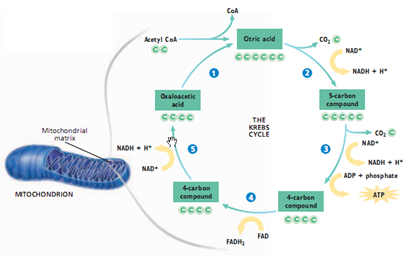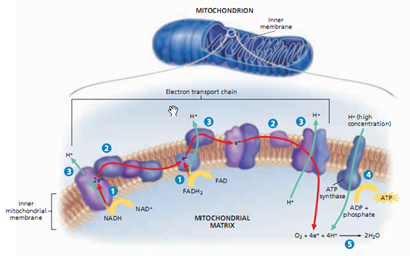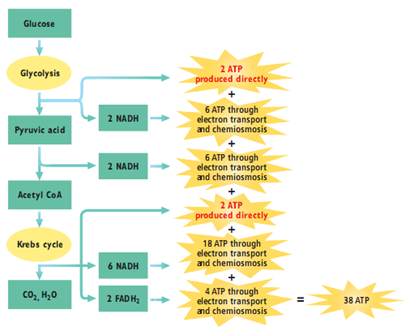Aerobic respiration has two major stages: the Krebs cycle and the electron transport chain, which is associated with chemiosmosis (using the energy released as protons move across a membrane to make ATP). In the Krebs cycle, the oxidation of glucose that began with glycolysis is completed. As glucose is oxidized, NAD is reduced to NADH. In the electron transport chain, NADH is used to make ATP. Although the Krebs cycle also produces a small amount of ATP, most of the ATP produced during aerobic respiration is made through the activities of the electron transport chain and chemiosmosis. The reactions of the Krebs cycle, the electron transport chain, and chemiosmosis occur only if oxygen is present in the cell.
In prokaryotes, the reactions of the Krebs cycle and the electron transport chain take place in the cytosol of the cell. In eukaryotic cells, however, these reactions take place inside mitochondria rather than in the cytosol. The pyruvic acid that is produced in glycolysis diffuses across the double membrane of a mitochondrion and enters the mitochondrial matrix. The mitochondrial matrix is the space inside the inner membrane of a mitochondrion. The mitochondrial matrix contains the enzymes needed to catalyze the reactions of the Krebs cycle.
Krebs cycle
When pyruvic acid enters the mitochondrial matrix, it reacts with a molecule called coenzyme A to form acetyl coenzyme A, abbreviated acetyl CoA. The acetyl part of acetyl CoA contains two carbon atoms, but as you learned earlier, pyruvic acid is a three-carbon compound. The carbon atom that is lost in the conversion of pyruvic acid to acetyl CoA is released in a molecule of CO2. This reaction reduces a molecule of NAD to NADH.
The Krebs cycle is a biochemical pathway that breaks down acetyl CoA, producing CO2, hydrogen atoms, and ATP. The reactions that make up the cycle were identified by Hans Krebs (1900–1981), a German biochemist. The Krebs cycle has five main steps. In eukaryotic cells, all five steps occur in the mitochondrial matrix. In step , a two-carbon molecule of acetyl CoA combines with a four-carbon compound, oxaloacetic acid, to produce a six-carbon compound, citric acid. Notice that this reaction regenerates coenzyme A.
 |
| The Krebs cycle takes place in the mitochondrial matrix and involves five main steps. |
In step 2, citric acid releases a CO2 molecule and a hydrogen atom to form a five-carbon compound. By losing a hydrogen atom with its electron, citric acid is oxidized. The electron in the hydrogen atom is transferred to NAD, reducing it to NADH.
In step 3, the five-carbon compound formed in step also releases a CO2 molecule and a hydrogen atom, forming a four-carbon compound. Again, NAD is reduced to NADH. Notice that in this step a molecule of ATP is also synthesized from ADP.
In step 4, the four-carbon compound formed in step releases a hydrogen atom to form another four-carbon compound. This time, the hydrogen atom is used to reduce FAD to FADH2. FAD, or flavin adenine dinucleotide, is a molecule very similar to NAD. Like NAD, FAD accepts electrons during redox reactions.
In step 3, the five-carbon compound formed in step also releases a CO2 molecule and a hydrogen atom, forming a four-carbon compound. Again, NAD is reduced to NADH. Notice that in this step a molecule of ATP is also synthesized from ADP.
In step 4, the four-carbon compound formed in step releases a hydrogen atom to form another four-carbon compound. This time, the hydrogen atom is used to reduce FAD to FADH2. FAD, or flavin adenine dinucleotide, is a molecule very similar to NAD. Like NAD, FAD accepts electrons during redox reactions.
In step 5, the four-carbon compound formed in step releases a hydrogen atom to regenerate oxaloacetic acid, which keeps the Krebs cycle operating. The electron in the hydrogen atom reduces NAD to NADH.
Recall that in glycolysis one glucose molecule produces two pyruvic acid molecules, which can then form two molecules of acetyl CoA. Thus, one glucose molecule is completely broken down in two turns of the Krebs cycle. These two turns produce four CO2 molecules, two ATP molecules, and hydrogen atoms that are used to make six NADH and two FADH2 molecules. The CO2 diffuses out of the cells and is given off as waste. The ATP can be used for energy. But note that each glucose molecule yields only two molecules of ATP through the Krebs cycle—the same number as in glycolysis. The bulk of the energy released by the oxidation of glucose still has not been transferred to ATP. Glycolysis of one glucose molecule produces two NADH molecules, and the conversion of the two resulting molecules of pyruvic acid to acetyl CoA produces two more.Adding the six NADH molecules from the Krebs cycle gives a total of 10 NADH molecules for every glucose molecule that is oxidized. These 10 NADH molecules and the two FADH2 molecules from the Krebs cycle drive the next stage of aerobic respiration. That is where most of the energy transfer from glucose to ATP actually occurs.
Electron Transport Chain
The electron transport chain, linked with chemiosmosis, constitutes the second stage of aerobic respiration. Recall that the electron transport chain is a series of molecules in a membrane that transfer electrons from one molecule to another.
In eukaryotic cells, the electron transport chain and the enzyme ATP-synthase are embedded in the inner membrane of the mitochondrion in folds calledcristae. In prokaryotes, the electron transport chain is in the cell membrane.ATP is produced by the electron transport chain when NADH and FADH2 release hydrogen atoms, regenerating NAD and FAD. To understand how ATP is produced, you must follow what happens to the electrons and protons that make up these hydrogen atoms.
The electron transport chain, linked with chemiosmosis, constitutes the second stage of aerobic respiration. Recall that the electron transport chain is a series of molecules in a membrane that transfer electrons from one molecule to another.
In eukaryotic cells, the electron transport chain and the enzyme ATP-synthase are embedded in the inner membrane of the mitochondrion in folds calledcristae. In prokaryotes, the electron transport chain is in the cell membrane.ATP is produced by the electron transport chain when NADH and FADH2 release hydrogen atoms, regenerating NAD and FAD. To understand how ATP is produced, you must follow what happens to the electrons and protons that make up these hydrogen atoms.
| Electron transport and chemiosmosis take place along the inner mitochondrial membrane and involve five steps. |
The electrons in the hydrogen atoms from NADH and FADH are at a high energy level. In the electron transport chain, these electrons are passed along a series of molecules embedded in the inner mitochondrial membrane.
In step 1, NADH and FADH give up electrons to the electron transport chain.NADH donates electrons at the beginning, and FADH donates them farther down the chain. These molecules also give up protons (hydrogen ions, H+).
In step 2, the electrons are passed down the chain. As they move from molecule to molecule, they lose energy.
In step 3, the energy lost from the electrons is used to pump protons from the matrix, building a high concentration of protons between the inner and outer membranes. Thus, a concentration gradient of protons is created across the inner membrane. An electrical gradient is also created, as the protons carry a positive charge.
In step 4, the concentration and electrical gradients of protons drive the synthesis of ATP by chemiosmosis. ATP synthase molecules are embedded in the inner membrane, near the electron transport chain molecules. As protons move through ATP synthase and down their concentration and electrical gradients, ATP is made from ADP and phosphate.
In step 5, oxygen is the final acceptor of electrons that have passed down the chain. Oxygen also accepts protons that were part of the hydrogen atoms supplied by NADH and FADH. The protons, electrons, and oxygen all combine to form water, as shown by the equation in step 5.
How many ATP molecules are made in cellular respiration? Recall that glycolysis and the Krebs cycle each produce two ATP molecules directly for every glucose molecule that is oxidized. Furthermore, each NADH molecule that supplies the electron transport chain can generate three ATP molecules, and each FADH molecule can generate two ATP molecules. Thus, the 10 NADH and two FADH molecules made through glycolysis, conversion of pyruvic acid to acetyl CoA, and the Krebs cycle can produce up to 34 ATP molecules by the electron transport chain and chemiosmosis. Adding the four ATP molecules from glycolysis and the Krebs cycle gives a maximum yield of 38 ATP molecules per molecule of glucose.
Cellular respiration occurs in two stages, as listed and shown in figure below.









0 comments :
Post a Comment